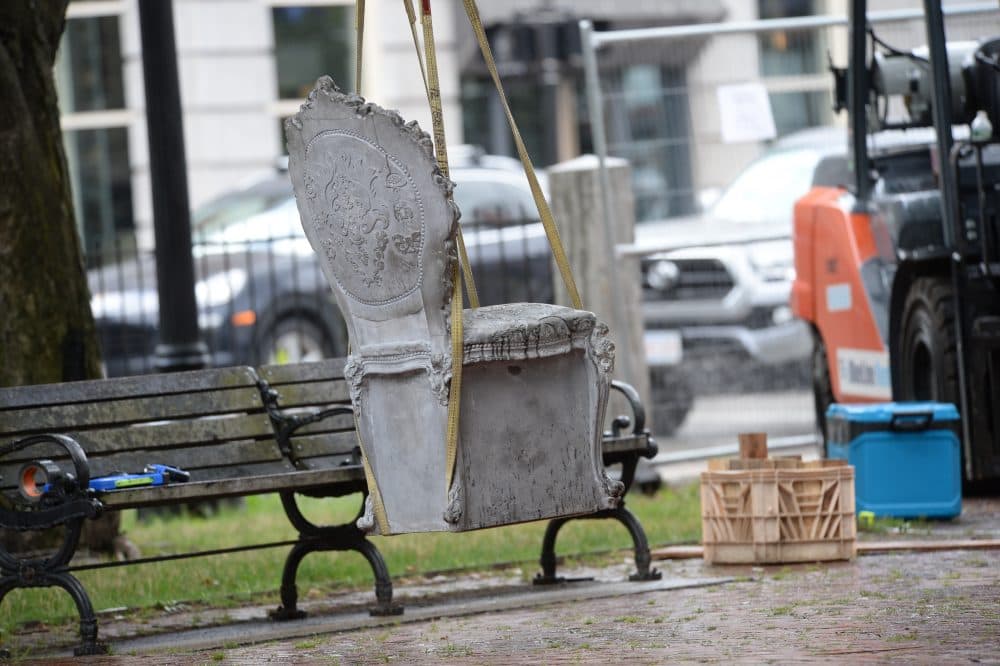Advertisement
Art Installation In Kenmore Square Transforms An Opulent Ballroom Into A Ruin

In Kenmore Square, you'll find opulent French furniture on the pathway in the middle of Commonwealth Avenue. But look closely, and you'll see a twist.
One of the pieces of furniture, a replica of a French Louis XIV footstool, with extravagant carvings and a lavish, plush cushion — or at least what looks like a cushion — appears like a petite artifact from a distant past.

Except its looks, at least from a distance, are deceiving. There is no plush fabric and the seemingly dainty footstool weighs 500 pounds. It, and more than half a dozen pieces of furniture around it, are made of cast concrete.
"Concrete is a material of the people," said artist Liz Glynn, who made the furniture as a public art installation called "Open House." The pieces are modeled after 26 sofas, chairs, footstools and arches from the opulent ballroom inside the mansion of Gilded Age aristocrat William C. Whitney. The ballroom, designed by architect Stanford White, was so exclusive, it was only used for an annual party for the most elite New Yorkers.
"I want to take this rarefied space that was designed originally for the most exclusive 1,000 members of elite society in New York City and open it to everyone for everyone to use," said Glynn.
Glynn is an international artist, having shown her work in many major institutions, from the New Museum in New York to LACMA in Los Angeles, and the Barbican art gallery in London. But in a way, this installation is a homecoming: Glynn was raised in Braintree and attended Harvard for her undergraduate education.
Originally commissioned by the Public Art Fund and displayed in New York City's Central Park, "Open House" is meant to be an open air ruin, like the Parthenon in Greece, or the Colosseum in Italy. It also plays on the idea of democratizing the most inaccessible spaces. Even the materiality of "Open House" asks us to ponder class.
Advertisement
Here's a look at the exhibit in New York City:
"I was interested in using concrete in particular because it was used historically in many of the modernist housing projects by architects like Le Corbusier to house the masses, in a well-designed functional way," said Glynn. "And today we see concrete more in public parks and a lot of modern contemporary architecture — but architecture that's often shared spaces."
Glynn also explores why we're so intrigued by the fantasy of rarefied spaces. "I was thinking about the way that this fantasy wasn't just the provenance of an elite group of people but that the idea of becoming part of this elite is part of what in someway supports the social structure that allows it to perpetuate."
"Open House" is situated a few yards from the Boston Hotel Buckminster — also designed by Standford White, the architect who created the ballroom that housed the original furniture. "I think the site that we chose is very important to the work's message," said Kate Gilbert, the executive director of Now + There, the nonprofit that brought "Open House" to Boston. "The artwork is saying, 'Hey remember the past as we're building the future.'"
Gilbert believes Boston has long lacked thought-provoking public art, compared to other major cities. She hopes "Open House" inspires other developers, nonprofits and park owners to look at public art as a way to unlock conversations and to rethink the use of public spaces.

Installing "Open House" was incredibly laborious. Now + There had to dig out every brick in one of the enclosed pathways of the Commonwealth Avenue Mall, put in a concrete base underground, lay the bricks again and then drill the 500 to 800-pound furniture into the ground. It also required four different permits from the MBTA and the city.
For Glynn, who is now based in Los Angeles, the installation is a meditation on class and culture. "'Open House' thinks a lot about the question of who has access to high quality space in cities like New York and Boston and Los Angeles ... where income inequality is one of the defining problems of the present moment."
She has taken a symbol of American extravagance, of inaccessible wealth and transformed it into a space for all — a democratizing force.
"Open House" is on view at the Commonwealth Avenue Mall in Kenmore Square until November.
This segment aired on July 26, 2018.
